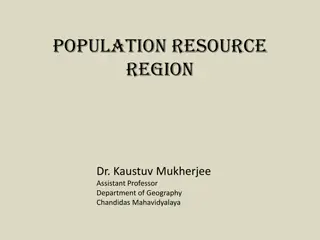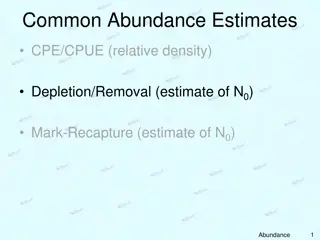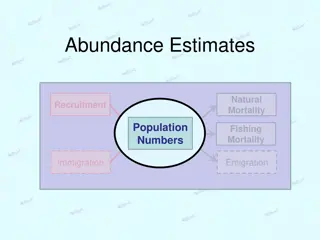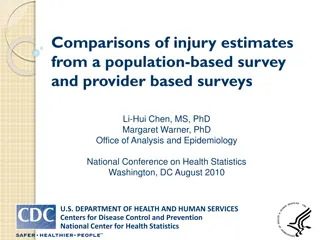Population and Migration Estimates April 2023 Insights
Comprehensive analysis of population trends from 1951 to 2023, emphasizing the recent data for 2022 and 2023. Highlights include vital events, immigration patterns, and emigration trends, shedding light on population dynamics in the specified period. The report reveals important shifts in demographi
1 views • 14 slides
Overview of the South African National Population Register
The South African National Population Register (NPR) is a vital system maintained by the Department of Home Affairs. It serves to record and update information on the country's resident population, issue identity documents, and handle related administrative tasks. The NPR has evolved over the years
2 views • 16 slides
Understanding Population Ecology and Demography Through Leslie Matrices
Explore the critical aspects of population ecology and demography, focusing on factors influencing abundance, population growth, regulation, and the impacts of climate change. Learn about population projections, growth models, age-structured populations, and data requirements for estimating populati
4 views • 35 slides
Impact of Human Population Growth on Environment and Welfare
The rapid growth of the human population is placing immense pressure on the environment, leading to increased demand for resources like food, water, and shelter. The effects of human activity on the environment have escalated significantly over the years due to population expansion. High birth rates
0 views • 8 slides
Overview of 2020 Census Post-Census Group Quarters Review
The 2020 Post-Census Group Quarters Review (PCGQR) is a program developed by the Census Bureau to address discrepancies in group quarters population counts from the 2020 Census. This initiative allows governmental units in the US and Puerto Rico to request a review of their group quarters' populatio
0 views • 12 slides
Introduction to Sampling in Statistics
Sampling in statistics involves selecting a subset of individuals from a population to gather information, as it is often impractical to study the entire population. This method helps in estimating population characteristics, although it comes with inherent sampling errors. Parameters represent popu
2 views • 24 slides
Understanding Population-Resource-Region Relationship: A Geographical Perspective
Explore the intricate relationship between population, resources, and regions through a geographical lens. Delve into classifications based on population, resources, and technology, with examples from different countries and regions. Discover the concepts of optimum population, over-population, and
1 views • 11 slides
Understanding Demography: Population Trends and Analysis
Demography is the study of population size, distribution, and composition, encompassing elements such as mortality, natality, migration, and demographic forces. Population census plays a crucial role in collecting and analyzing demographic data, with methods like De Jure and De Facto census. Inter-c
6 views • 21 slides
Comparing 1750 to 1900: Population Growth in Britain
The population of Britain saw a significant increase between 1750 and 1900. In 1750, the population was 7 million, and by 1900, it had grown to 37 million. This represented an 87% increase. The number of people living in towns also rose from 13% to a higher percentage. Factors contributing to this g
0 views • 6 slides
Population Resource Regions and Zelinsky's Classification
Geographers have long studied the relationship between population growth and resource adequacy, leading to the concept of Population Resource Regions (PRR) by W. Zelinsky. Zelinsky identified five types of PRR based on population-resource ratios, ranging from Type A with high resource utilization po
0 views • 8 slides
Overview of Occupational Requirements Survey (ORS) and 2020 Estimates
The Occupational Requirements Survey (ORS) by the Bureau of Labor Statistics provides detailed insights into the occupational demands of various job roles, including physical, cognitive, and environmental requirements. The survey encompasses data on speaking requirements, weight lifting capabilities
0 views • 22 slides
Breast Cancer Survival Disparities by Molecular Subtypes in the US
Breast cancer molecular subtypes play a crucial role in determining survival outcomes. This study by Nadia Howlader, PhD, from the National Cancer Institute, presented the first nationally representative estimates of breast cancer survival by four main molecular subtypes. The research aimed to under
1 views • 23 slides
Maryland Revenue Estimates & Economic Outlook March 2022
The revenue estimates and economic outlook for Maryland in March 2022 show growth in income taxes, sales and use taxes, and other revenues. Detailed figures for fiscal years 2021-2023 indicate estimates and actual data for various tax types like individual and corporate income taxes. The changes in
0 views • 17 slides
Analyzing Deepwater Disaster: Inaccurate Oil Spill Estimates
Explore the Deepwater Horizon disaster, where oil spill estimates were inaccurate due to various factors such as convoluted discharges, technological limitations, and reluctance to share data. Consequences of underestimation and reasons behind flawed estimates are discussed, shedding light on the ch
0 views • 13 slides
Provisional Gross Domestic Product (GDP) Estimates Presentation April 11, 2018
The release provides provisional GDP estimates for the fourth quarter of 2017, along with revised estimates for the first three quarters of 2017 and annual estimates for 2016. The GDP measures the value of goods and services produced in the country. The estimation of GDP is done in stages, with prov
0 views • 33 slides
Improvement of Population and Vital Statistics Metadata in the Demographic Yearbook System
The Demographic Yearbook system focuses on enhancing population and vital statistics metadata to ensure accurate and concise reflection of population concepts across 230+ countries. It involves annual collection of official national population estimates, vital statistics, and UN international travel
0 views • 16 slides
Guidelines for Acceptable Estimates in Online Applications
Examples of acceptable and non-acceptable estimates in online applications for infrastructure projects. Criteria include clear itemization, exclusion of unnecessary fees, proper documentation of road names, and accurate unit measurements to avoid common errors. These guidelines help ensure accuracy
0 views • 7 slides
GAO Cost and Schedule Assessment Guides: Enhancing Government Accountability
The Government Accountability Office (GAO) plays a crucial role in supporting Congress to fulfill its responsibilities by improving federal government performance and ensuring accountability. The GAO Cost Estimating and Assessment Guide outlines criteria for assessing cost estimates, and the Reliabl
0 views • 19 slides
Best Practices for Contractors: Examples of Acceptable and Non-Acceptable Estimates and Bids
Explore examples of acceptable and non-acceptable estimates and bids for contractors in online applications. Learn why lump sum estimates, lack of detailed information, and incorrect unit bidding can impact the bidding process negatively. Discover how clarity, itemization, and adherence to bidding s
0 views • 13 slides
Understanding Estimation and Confidence Intervals in Statistics
Explore the concepts of point estimates and interval estimates in statistics. Learn how to construct confidence intervals for the mean and proportion, consider the finite population correction factor, choose an appropriate sample size, and calculate confidence levels using known population standard
0 views • 25 slides
Fisheries Abundance Estimates and Depletion Methods
Explore common abundance estimation techniques like CPUE, mark-recapture, and depletion methods. Understand how to calculate relative density, depletion estimates, and cumulative catch. Discover the concepts of N0, Nt, Ct, and q in depletion estimates using regression models. Learn about the assumpt
0 views • 10 slides
Understanding Multiyear Estimates from the American Community Survey
This comprehensive guide delves into the concept of multiyear estimates from the American Community Survey (ACS). It explains what multiyear estimates are, when to use them, considerations to keep in mind, making comparisons with them, examples of their application, definitions of period and multiye
0 views • 35 slides
Understanding Abundance Estimates in Fisheries Management
Explore the concept of abundance estimates in fisheries management, including natural mortality, recruitment, population numbers, fishing mortality, immigration, and emigration. Learn about common abundance estimation methods like CPE/CPUE, depletion/removal estimates, and mark-recapture techniques.
0 views • 10 slides
Postharvest Loss Estimates for Cereals and Crops: A Practical Guide
Explore APHLIS website to access science-based estimates of postharvest losses for cereals and crops using an interactive calculator tool in Excel. Discover how to input location-specific data, select crop and climate zones, and obtain quality estimates for different harvest seasons. The APHLIS Calc
0 views • 38 slides
Lake Washington PCB/PBDE Study Estimates and Loading Pathways
This study presents estimates of loading of PCB/PBDE pollutants in Lake Washington from major pathways, including rivers, local drainages, and monitored tributaries. The data shows current PCB loading estimates to Lake Washington and its exits to Puget Sound, providing insights into sources and conc
0 views • 12 slides
Understanding Logistic Growth in Population Dynamics
Explore the logistic growth equation and its applications in modeling population dynamics. Dive into the concept of sigmoidal growth curves and the logistic model, which reflects population growth with limits. Learn how to calculate population change using the logistic growth equation and understand
0 views • 26 slides
Proportions in Capture-Recapture Method for Estimating Fish Population
Explore the capture-recapture method to estimate the total fish population in a habitat. Learn how to select and tag fish, replace goldfish with tagged fish, count and calculate proportions to determine population estimates. Repeat the procedure for accuracy and compare calculated estimates with the
0 views • 11 slides
Census 2021 Population and Household Estimates in Cambridgeshire and Peterborough
The Census 2021 data reveals significant population growth in Cambridgeshire and Peterborough, with the usual resident population increasing by 9.2% to 678,600 in Cambridgeshire and 17.5% to 215,700 in Peterborough compared to the Census 2011 figures. The total number of households has also seen an
0 views • 45 slides
Support Structure Fabrication Project Overview
An overview of a support structure fabrication project by Hanzel, focusing on procurement strategy, budgetary estimates, vendor quotes, and lead times for various components like yokes, loadpads, collars, master and false coils, aluminum shells, nitronic end plates, axial rods, and tension rods. The
0 views • 13 slides
Overview of Population Measures and District Data from Census Reports
The census reports various population measures including total population, voting age population, and citizen voting age population. The data includes breakdowns by ethnicity for each trustee district. Changes in voting and citizen voting age population percentages are also provided. Data is sourced
0 views • 4 slides
A Comparison of Injury Estimates from Population-Based and Provider-Based Surveys
This study compares injury estimates obtained from a population-based health survey with estimates from two provider-based surveys. Data from the National Health Interview Survey (NHIS), National Hospital Ambulatory Medical Care Survey (NHAMCS-ED), and National Hospital Discharge Survey (NHDS) are a
0 views • 18 slides
Utilizing Administrative Data for Census 2021: Insights and Strategies
Providing a comprehensive overview of the historical use of administrative data for census purposes, this content delves into methodologies adopted in previous censuses, such as hand-delivery, online attempts, and administrative data enrichment. It also outlines plans for the 2021 census, focusing o
0 views • 19 slides
Overview of Ireland's Demographic Data Collection
Ireland conducts a Census of Population every 5 years, with the most recent in 2016. Inter-Census Population Estimates are obtained annually using demographic methods. For the 2020 European Census cycle, Ireland is holding a traditional Census in 2022 due to COVID-19 impacts. A pilot administrative
0 views • 8 slides
Understanding Population Pyramids for Analyzing Population Trends
Population pyramids are graphical illustrations that showcase the distribution of age groups within a population, segmented by gender. By observing and documenting the patterns of population pyramids, one can discern trends such as rapid growth, slow growth, or negative growth, which are influenced
0 views • 7 slides
Insights from India Maize Summit 2013: Market Trends and Production Estimates
Discover key highlights from the India Maize Summit 2013 in New Delhi, showcasing global maize market trends, production estimates, export destinations, challenges, and India's role in international trade. Explore data on maize production, trade, consumption, and stocks globally and in India, along
0 views • 13 slides
Enhanced Flow Estimates in NHDPlus Version 02 Presentation
Presentation by Tim Bondelid at the ESRI International User Conference discussing the Enhanced Runoff Method (EROM) in NHDPlus Version 02 for improved stream flow estimates. Highlights the importance of accurate flow estimates for various water-related goals and the methodology used to enhance flow
0 views • 18 slides
Understanding Confidence Intervals and Point Estimates in Statistics
Explore how confidence intervals are constructed around point estimates such as sample mean in statistics. Learn the significance of confidence levels and how to develop confidence intervals using practical examples. Follow step-by-step instructions to analyze data and interpret results for populati
0 views • 20 slides
Maine Workforce and Population Trends Analysis 2014-2024
Maine's workforce and population outlook from 2014 to 2024 reveals a decline in births, resulting in an aging population and workforce imbalance. The state faces challenges due to low birth rates, negative natural population change, and minimal net migration, impacting labor force growth and total p
0 views • 31 slides
The Global Human Population Explosion: Causes and Implications
The lecture explores the rapid increase in the global human population post-World War II, analyzing factors such as birth rates, mortality rates, and life expectancy. Various counterarguments are presented, including the debate on population growth benefits, ethical concerns over reproductive interf
0 views • 20 slides
Model-Based Early Estimates for Health Statistics Enhancement
The National Center for Health Statistics (NCHS) is working on improving the timeliness and granularity of data through model-based early estimates. Their goal is to enable data-driven actions, predict deaths, and report data accurately. The NCHS is focusing on enhancing their data systems and produ
0 views • 6 slides







































